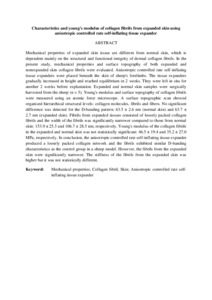Citation
Manssor, Nur Aini S. and Radzi, Zamri and Yahya, Noor Azlin and Mohamad Yusof, Loqman and Hariri, Firdaus and Khairuddin, Nurul Hayah and Abu Kasim, Noor Hayaty and Czernuszka, Jan T.
(2016)
Characteristics and young's modulus of collagen fibrils from expanded skin using anisotropic controlled rate self-inflating tissue expander.
Skin Pharmacology and Physiology, 29 (2).
pp. 55-62.
ISSN 1660-5527; ESSN: 1660-5535
Abstract
Mechanical properties of expanded skin tissue are different from normal skin, which is dependent mainly on the structural and functional integrity of dermal collagen fibrils. In the present study, mechanical properties and surface topography of both expanded and nonexpanded skin collagen fibrils were evaluated. Anisotropic controlled rate self-inflating tissue expanders were placed beneath the skin of sheep's forelimbs. The tissue expanders gradually increased in height and reached equilibrium in 2 weeks. They were left in situ for another 2 weeks before explantation. Expanded and normal skin samples were surgically harvested from the sheep (n = 5). Young's modulus and surface topography of collagen fibrils were measured using an atomic force microscope. A surface topographic scan showed organized hierarchical structural levels: collagen molecules, fibrils and fibers. No significant difference was detected for the D-banding pattern: 63.5 ± 2.6 nm (normal skin) and 63.7 ± 2.7 nm (expanded skin). Fibrils from expanded tissues consisted of loosely packed collagen fibrils and the width of the fibrils was significantly narrower compared to those from normal skin: 153.9 ± 25.3 and 106.7 ± 28.5 nm, respectively. Young's modulus of the collagen fibrils in the expanded and normal skin was not statistically significant: 46.5 ± 19.4 and 35.2 ± 27.0 MPa, respectively. In conclusion, the anisotropic controlled rate self-inflating tissue expander produced a loosely packed collagen network and the fibrils exhibited similar D-banding characteristics as the control group in a sheep model. However, the fibrils from the expanded skin were significantly narrower. The stiffness of the fibrils from the expanded skin was higher but it was not statistically different.
Download File
![[img]](http://psasir.upm.edu.my/55253/1.hassmallThumbnailVersion/Characteristics%20and%20young%27s%20modulus%20of%20collagen%20fibrils%20from%20expanded%20skin%20using%20.pdf)  Preview |
|
Text (Abstract)
Characteristics and young's modulus of collagen fibrils from expanded skin using .pdf
Download (5kB)
| Preview
|
|
Additional Metadata
Actions (login required)
 |
View Item |

